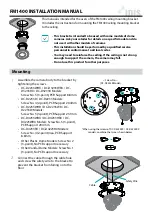
Operator’s Manual: 2200-TL Series Conveyor
3-8
10.2015
3.3 MACHINE BREAK-IN
There is no operational restrictions on the conveyor
when used for the first time.
The conveyor belt’s alignment is set at the factory, to
track correctly without carrying a load. It is important
to check alignment and make adjustments, if
required, during the first few minutes of operation.
It is recommended that the following procedural and
mechanical items be checked:
Before Starting Work:
1. Read the conveyor and engine operator’s
manuals.
2. Run the unit for half an hour to seat the conveyor
belt and flashing around the intake hopper. It is
normal for rubber from the flashing to be expelled
out the discharge and form a pattern on the belt.
After Operating for 1/2 hour:
3. Re-torque all the wheel bolts, fasteners and
hardware.
4. Check fuel level, engine oil level and hydraulic
oil level.
5. During the conveyors first few minutes of
operation, check belt alignment to ensure preset
alignment and tension does not vary under
loaded conditions. Adjust as required.
6. Check the flashing seal on the input hopper. If
any product comes out of the hopper around the
flashing; stop the belt, loosen flashing mounting
screws and adjust. Retighten anchor screws and
try again. Repeat until no grain is lost.
7. Check condition of all hydraulic lines, hoses and
connections. Repair or replace any damaged
system components.
8. Check that all guards are installed and working
as intended.
After Operating For 5 Hours and 10 Hours:
Repeat steps 1 through 8 above.
Go to the normal servicing and maintenance
schedule as defined in the Section 4: Service and
Maintenance.
3.4 PRE-OPERATION CHECKLIST
Efficient and safe operation of the conveyor requires
that each operator knows the operating procedures.
It is important for both the personal safety and
maintaining the good mechanical condition of the
machine that this checklist is followed.
Before operating the conveyor, and each time
thereafter, the following areas should be checked.
1. Check worksite. Clean up working area to
prevent slipping or tripping.
2. Be sure that the battery is fully charged. If
needed, charge the battery before connecting it
with the battery cables.
3. Lubricate and service the machine as per the
schedule outlined in the Section 4.2.
4. Check that all guards are installed, secured and
functioning as intended. Do not operate with
missing or damaged shields.
5. Check that the belt is properly tensioned and
aligned. Ensure it is not frayed or damaged.
Refer to Section 4.3.1 and 4.3.2
6. Be sure conveyor wheels are chocked.
7. Check that discharge and intake areas are free of
obstructions.
NOTICE: Upending Hazard
Anchor or support conveyor during
operation. When lower half empties of
material, the weight balance transfers to
the discharge end of the machine, which
can cause upending.
Summary of Contents for 2245-TL
Page 1: ...TRANSLOADING CONVEYOR Models 2245 TL 2252 5 TL OPERATOR S MANUAL...
Page 4: ...This page intentionally left blank...
Page 8: ...Operator s Manual 2200 TL Series Conveyor 1 2 10 2015 This page intentionally left blank...
Page 48: ...Operator s Manual 2200 TL Series Conveyor 4 14 10 2015 This page intentionally left blank...
Page 54: ...Operator s Manual 2200 TL Series Conveyor 6 2 10 2015 This page intentionally left blank...
















































